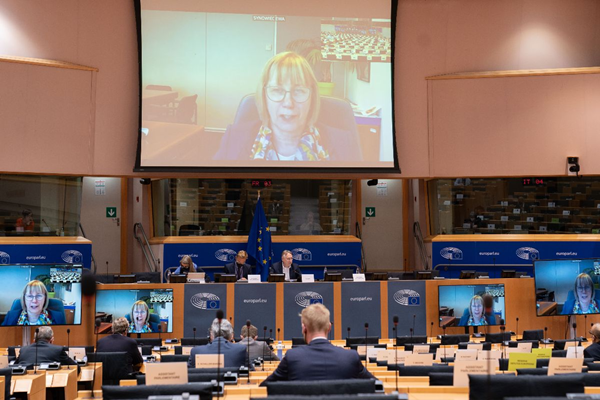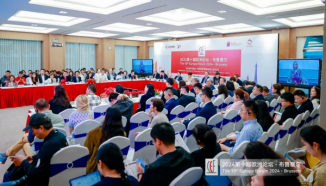The CCCEU Weekly Update 29 April 2022: Sino-EU relations: Foreign subsidies, IPI, forced labour product ban…

On April 25, 2022, the European Parliament's INTA committee vote on new rules against foreign subsidies. Source: EP.
Welcome to the CCCEU Weekly Update! This week, there's a lot to keep track of: Chinese businesses are carefully watching two key legislation proposals that INTA voted unanimously in favour. Additionally, the Berlaymont was mulling bringing in a new forced-labor product ban in September. China's and EU's authorities, as well as think tanks, have revealed upbeat trade and investment data between the two sides. Beijing continued to extend an olive branch in an effort to thaw ties with Brussels, while European leaders turned their attention to China's neighbours, such as India and Japan. Enjoy reading, and have a lovely weekend or holiday break!
It has been a busy week for EU trade policies, China-EU trade data, and all diplomatic efforts! The CCCEU Weekly Update is here to help you comb through it.
First thing first, Brussels was racing to develop its trade tools. The International Trade Committee (INTA) of the European Parliament gave the green light to two instruments on Monday: one on foreign subsidies and the other, the International Procurement Instrument (IPI). Both were passed unanimously, with a promising prospect in the plenary beckoning in May or June. More than that, European parliamentarians and commission officials were debating a brand new ban on forced-labour products, which is expected to be proposed before mid-September.
On foreign subsidies, INTA said its approved proposal will grant the European Commission the power to investigate and redress "distortions." It also wanted to lower notification thresholds, which were reduced from the EC's proposed €500 million to €400 million for acquisitions and joint ventures; and for public procurement, from €250 million to €200 million. Only foreign subsidies of less than €4 million should be considered "non-distortive" by INTA, thus broadening the scope of future regulation. The plenary’s vote on INTA’s draft report is scheduled for early May, according to INTA’s press release.
In the EU's legislative procedure, IPI is further ahead. In March, a provisional agreement was achieved, and IPI's approval in INTA will put it on the European Parliament's final voting agenda in June. The instrument should go into effect after it is approved by EU member states.
Here, we'd like to share with you the view of a senior Chinese official on IPI.
Mr. Peng Gang, minister in charge of business and commerce at the Chinese Mission to the EU, disputed the notion that the Chinese public procurement sector is closed to European enterprises during a webinar co-hosted by the CCCEU and the EUCBA on Monday.
Mr. Peng told the online audience of about a hundred people that "in fact, EU companies have already entered the Chinese procurement market through various channels and, thanks to their good reputation and recognition, have a relatively stable share, with procurement amounts exceeding tens of billions of RMB."
A bilateral government procurement discussion mechanism was formed between China and the EU in 2005. While China is trying to join the WTO Government Procurement Agreement (GPA) "as soon as possible," Peng stated that the government is open to work with the EU and begin negotiating a bilateral procurement agreement at the appropriate time.
As long as China can join the GPA as soon as possible or as long as China and the EU can achieve a bilateral procurement deal, the IPI will not be a bother. “Of course, none of this would be possible without the European side's collaboration and assistance, "he added.
A proposal for an EU ban on forced labour goods will have a self-imposed deadline of mid-September, , in time for Von der Leyen's state of the union speech Finbarr Bermingham, SCMP’s Europe Correspondent, tweeted.
According to EU lawmakers and officials, the ban must apply to both domestic and imported products and must "be careful not to single out any country," implying that a targeted ban on products from China's Xinjiang is unlikely, he tweeted. A call for evidence is expected in mid-May.
Following that, this week has seen a flurry of important data being released (you will find more below). China-EU trade and investment ties have remained strong. For example, Rhodium Group and MERICS recently published a report on Chinese FDI in the EU 27 and the UK, claiming that Chinese investment increased by more than 30% in 2021, with greenfield investment accounting for nearly a third of total Chinese FDI.
In 2021, the Netherlands received the most Chinese investment, followed by Germany, France, and the UK, said the report.
On the other hand, the negative repercussions of the Ukraine war and massive sanctions are surfacing, with European inflation at an all-time high and energy and commodity prices continuing to soar. Economic development in major EU countries has been impeded, with France's economy unexpectedly halting in the first quarter and data from Germany and Spain falling short of expectations, pushing down Eurozone and EU economic growth.
Finally, the difference between China's recent engagement with Europe and the EU's engagement with the Asia-Pacific area is noteworthy.
Recently, senior Chinese diplomats have been crossing Europe, and Sino-EU research, technology, and education exchanges have been announced.
For instance, Ambassador Liu Xiaoming, China's special representative on Korean Peninsula affairs, met with EEAS senior officials during his stop in Brussels. Liu visited Moscow, Washington D.C., Paris, Berlin, and Bern before coming to town and has returned to London, where he served for 11 years as China's Ambassador.
China and the EU also reached an administrative arrangement for a co-funding mechanism for the period 2021–2024 to support collaborative research and innovation projects, focusing on areas such as food, agriculture, biotechnologies, climate change, and biodiversity.
Instead, Europe has launched a diplomatic drive in the Asia-Pacific region, with President von der Leyen visiting India and German Chancellor Scholz devoting his first Asian tour only to Japan after taking office.
New Delhi and Brussels announced the formation of a TTC in India, the second since the TTC between the EU and the US was established. The two sides also agreed to resume FTA talks.
President von der Leyen suggested during her visit to India that China-Russia "no-limit" ties could pose a threat to the international order, provoking a backlash from Chinese media.
In summary, the Chinese side has continued to send signals of goodwill to Europe, with dialogue in various fields picking up speed, whereas the European side is positioning China as a "systemic rival," devoting increased diplomatic efforts to the Asia-Pacific region, following the China-EU summit.
Despite the pandemic, China-EU investment and trade flows continued to demonstrate great resilience, as evidenced by official and market data. However, the detrimental impacts of the war in Ukraine and massive sanctions on the EU economy are progressively becoming apparent, putting pressure on the future growth of China-EU relations, including economic and trade connections.
Sluggish economic growth in eurozone and major EU countries in Q1
According to Eurostat, in the first quarter of 2022, seasonally adjusted GDP increased by 0.2% in the euro area and by 0.4% in the EU, compared with the previous quarter, according to a preliminary flash estimate published by Eurostat, the statistical office of the European Union. In the fourth quarter of 2021, GDP grew by 0.3% in the euro area and 0.5% in the EU. These preliminary GDP flash estimates are based on data sources that are incomplete and subject to further revisions.
Compared with the same quarter of the previous year, seasonally adjusted GDP increased by 5.0% in the euro area and by 5.2% in the EU in the first quarter of 2022, after +4.7% in the euro area and +4.9% in the EU in the previous quarter.
Among the Member States for which data is available for the first quarter of 2022, Portugal (+2.6%) recorded the highest increase compared to the previous quarter, followed by Austria (+2.5%) and Latvia (+2.1%). Declines were recorded in Sweden (-0.4%) and Italy (-0.2%). The year-on-year growth rates were positive for all countries.
The German economy grew by 0.2 percent in the first quarter of this year, supported by higher investment, the German statistics office reported Friday. Data from France showed that the eurozone’s second biggest economy has unexpectedly ground to a halt — which is below the pre-release expectation among analysts of an expansion of 0.3 percent. In Spain, meanwhile, growth slowed to 0.3 percent, also undershooting expectations of a 0.5 percent expansion. Politico has the story.
China-EU trade rises 12.2% in Q1
Bilateral trade between China and the EU rose robustly in the first quarter, Gao Feng, spokesperson for the Ministry of Commerce, said on April 28.
Bilateral trade jumped 12.2 percent year-on-year to reach $205.87 billion, Gao said at a regular press conference.
China leads as the EU’s main import partner for raw materials
According to Eurostat, in 2021, the value of total trade (import plus exports) of raw materials between the EU and the rest of the world reached €178 billion. Since exports (€71.3 billion) were lower than imports (€106.8 billion), this resulted in a trade deficit of €35.5 billion. Between 2002 and 2021, EU trade in raw materials almost tripled, equivalent to average annual growth of 5.6%. In this period, exports (6.5%) grew faster than imports (5.0%).
China was the main export destination of raw materials, accounting for 16% of all extra-EU exports in 2021, followed by the United Kingdom (15%), Turkey and the United States (both 10%). These top four export partners accounted for about half of all extra-EU exports.
EU moves away from "emergency mode" of pandemic
The European Commission said on Tuesday that the bloc had entered a new phase of the pandemic, moving from emergency mode to a more sustainable management of COVID-19. It also announced actions to ensure resilient supply chains throughout the pandemic, both for medical countermeasures and for critical products across all industrial ecosystems.
Media: EU’s new ambassador to China goes to…
Spanish diplomat Jorge Toledo Albiñana, current ambassador to Japan, is to become the European Union's new ambassador to China, a report of China Table said. Toledo is currently Spain’s ambassador to Japan. The 57-year-old would succeed France’s Nicolas Chapuis as EU ambassador to Beijing, who is expected to step down from his post in the fall. The European External Action Service (EEAS) did not yet confirm the change.
What are experts talking about?
Institute of European Studies, Chinese Academy of Social Science posts "Some Insights from the Russia-Ukraine Crisis and China's Response," written by Wu Baiyi. The war in Ukraine will have a huge and far-reaching impact on the security and development trend of Europe and the world. Wu said his article tries focusing on clarifying the basic logic behind the crisis and summarizing its main enlightenment.
On April 1, the European Parliamentary Research Institute published an article “China-Russia relations: A quantum leap?” by Ulrich Jochheim. The article argues that the China-Russia relations have reached their peak since the creation of the Russian Federation. Currently, the relations have evolved into an informal alliance.
Please note: the English version of this issue is slightly different from our Chinese one. The views and opinions expressed in this article do not necessarily reflect the official position of the CCCEU.

 Login
Login Login
Login CCCEU and Gunnercooke Successfully Host Webinar on CSDDD and FLR Compliance to Guide Chinese Businesses
CCCEU and Gunnercooke Successfully Host Webinar on CSDDD and FLR Compliance to Guide Chinese Businesses Cultivating responsible China-EU business leaders essential to tackling global challenges
Cultivating responsible China-EU business leaders essential to tackling global challenges



